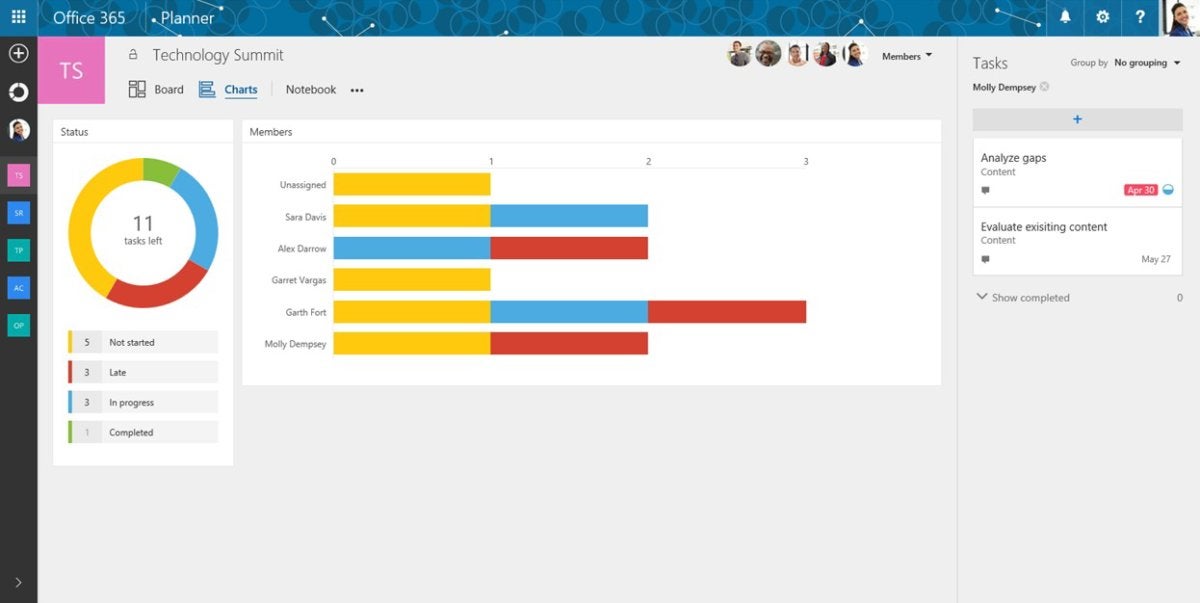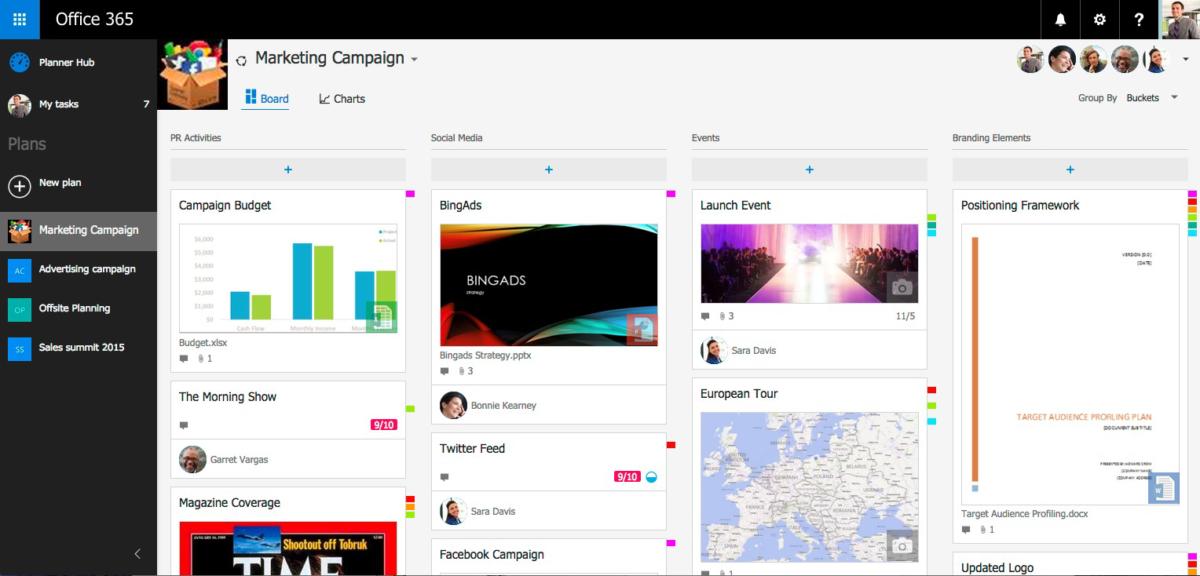Microsoft’s group chat tool, Teams, may have garnered more attention when it launched last year, leaving Planner – aimed at helping teams coordinate projects, share files and work more effectively – largely in the shadows.
Billed as a lightweight, collaborative and highly visual task management tool, Planner is positioned as a rival to the popular Trello (just as Microsoft’s Teams is seen as its answer to Slack). But in a crowded collaboration field, Planner also matches up against tools like as Asana and Smartsheet, which offer alternatives to more complex project management applications.
“Microsoft saw the collaboration market heating up, and responded with, in part, Microsoft Planner and a solid revamp of Microsoft Teams,” said IDC research director Wayne Kurtzman.
Planner and Teams are relatively new in comparison with more established collaboration tools, he said, but Microsoft has “aggressive plans” to compete with the growing and more mature products in the market.
How does Planner work?
The main way to interact with Planner is through the Board view, which contains task cards, each organized into lists or “buckets.” Individual cards contain information such as task description and due date. Files can be attached and team members can leave comments within the card. Team leaders can then assign a task to individuals or multiple team members, who will be notified by email.
Buckets are used to represent the status of a specific project. This may mean a task is dragged and dropped from a “To Do” bucket to “Completed” as work is wrapped up. Those who’ve used Trello already will find the way Planner functions familiar.
There is also a Charts view that provides a higher level overview of work that’s under way, enabling team members to see the status and progress of various projects at a glance. This makes it easier to see if a project falls behind schedule or when a team member has a looming deadline. The Charts view also shows which tasks a team member has been assigned, offering an overview of their current workload and work completed.
 Microsoft
Microsoft
A Planner Chart
Since launch, Microsoft has steadily added to Planner. This includes a refreshed UI, and new functionality such as a connector into Microsoft’s IFTTT-style app integration tool, Flow.
Support for iOS and Android devices was announced in May, enabling users to view and update plans on the go once they have been created using the web app and push notifications are now enabled for the app.
On Feb. 5, Microsoft unveiled further additions to Planner. A schedule view makes it simpler to plan projects and understand project status with daily, weekly and monthly overviews. There are new options for filtering tasks by due date and a Group feature to view tasks that are yet to start – changes designed to help users prioritize work. Planner users can also receive email notifications summarizing tasks due over the course of a week., (An iCalendar format feed is on its way, too.)
Planner strengths
So why choose Planner over the variety of other task management apps available
Planner’s most obvious strength lies in its integration with other Office 365 tools, such as Teams and Project. For example, it is possible to link a Project Online task to Planner. This allows a project manager to offload the management of a task to a colleague using Planner. Shared files are stored in SharePoint for easy access and each board is connected to a OneNote Notebook for team members to view. It is also integrated with Office365 Groups, making conversations available in Outlook.
Alongside the Office 365 integrations, another of Planner’s strengths is its ease of use, though it can get in the way of more in-depth management of team projects. This is by design: Microsoft already has a fully featured project management tool in Project.
“On the surface, Planner is a good, albeit simple workflow product for Office 365 users,” said Kurtzman. “The challenges come with more complex workflows, and enterprise reporting is still evolving.”
Planner sits somewhere in between note-taking and list apps such as Microsoft’s To-Do software. “Hardcore Microsoft Project users won’t want to, or be able to, give up the granularity of Project for the relatively basic, more visual day-to-day workflow [of Planner],” said Kurtzman.
451 Research senior analyst Raul Castañón-Martínez said Planner is better suited to less complex projects that require a collaborative approach. “It is also a more flexible tool and therefore can address a wide range of use cases,” he said.
Planner pricing
Planner is available as part of the following Office 365 subscriptions: E1-E5, Business Essentials, Business Premium and Education.
The inclusion of a task management app in Office 365 subscriptions offers Microsoft a point of differentiation over standalone options. “Microsoft is the incumbent provider in the enterprise and has such a huge footprint that it can afford to bundle its products to push out potential competitors,” said Castañón-Martínez.
 Microsoft
Microsoft
A Planner board.
As with tools available in Google’s G Suite, the integration makes it easier for many Office 365 subscribers to use Planner – or Teams – across their operation on the basis that the software is “good enough.” That’s especially true when companies may be paying for it anyway.
That said, Microsoft’s smaller competitors have their own advantages. Standalone, freemium tools such as Trello and Asana have benefited from widespread adoption by business users rather than adoption pushed by IT admins. Castañón-Martínez said employees have more influence than ever in terms of the tools they use to get their work done.
“In that sense the emerging vendors have the upper hand,” he said. “Microsoft cannot easily replicate the key advantage that the smaller, emerging vendors have in terms of organic, viral adoption; just like Slack, some of the competitors for Planner benefit from this.
“If end users prefer other tools, it will be very difficult to transition them into Planner,” Castañón-Martínez said.
More plans for Planner
According to Microsoft’s product roadmap, new Planner features in the pipeline include guest access that will support task assignment and collaboration with team members in separate organizations. Expected to launch in early 2018, guest access is designed to help teams collaborate with vendors and channel partners more effectively. Planner users will also soon be able to view all of their assigned tasks directly from Teams.
Although the entrance of Microsoft into the task management market represents a challenge for emerging providers, Castañón-Martínez does not foresee a “winner-takes-all” scenario. “There is room for vendors with point solutions such as Trello, Asana and Basecamp,” he said. “Some of these might eventually exit the space, but I expect some of them will remain and be successful.
“Furthermore, I believe the workplace of the future will see a more diverse set of tools from different vendors that play well together,” Castañón-Martínez said. “Microsoft and Google have not fully embraced this concept, but I expect they will eventually do so.”






